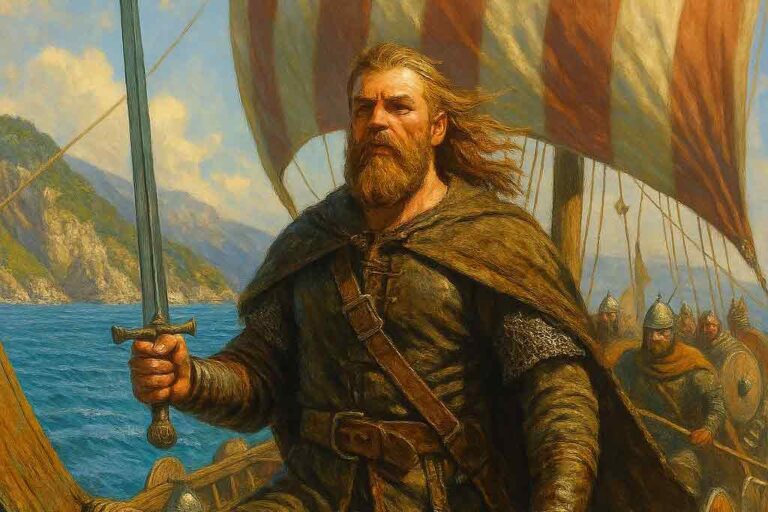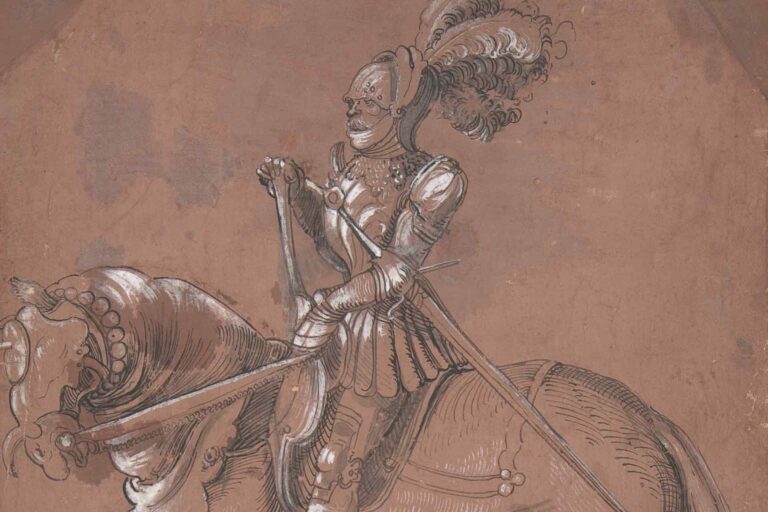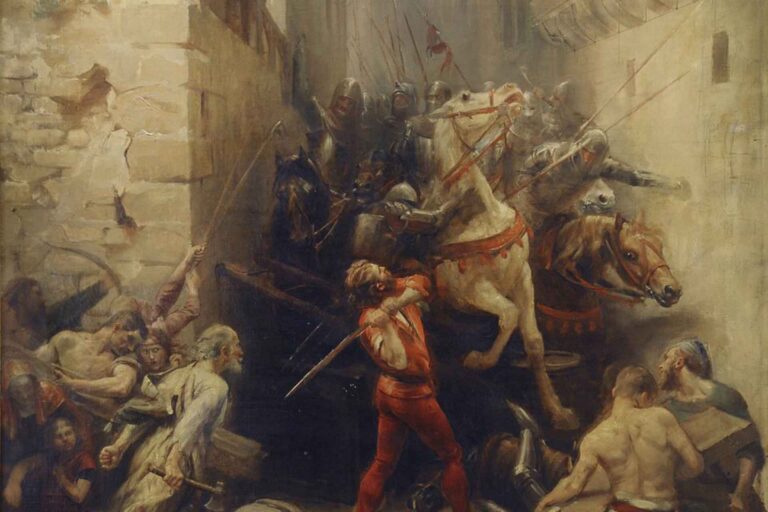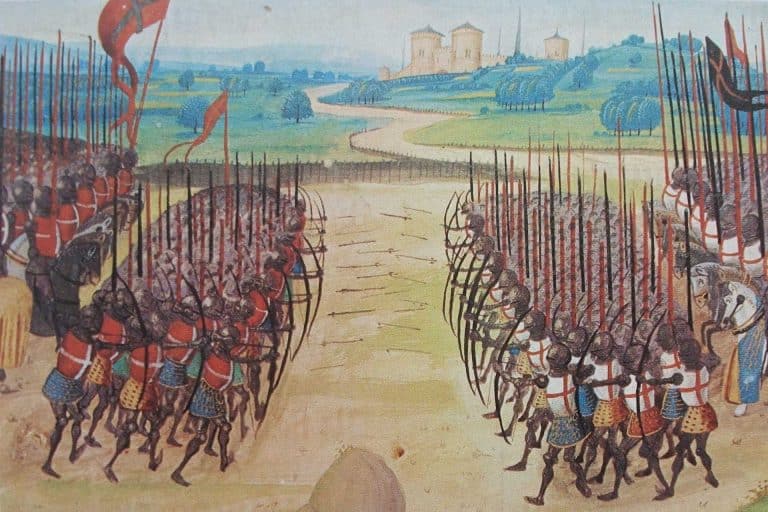Hvitserk: The Most Tormented Son of Ragnar Lothbrok
Ragnar Lothbrok, the legendary Norse warrior and king, left behind more than just a legacy of conquest—he fathered a line of sons whose names became synonymous with Viking power and myth. Among them were fierce warriors like Ivar the Boneless, Halfdan, and Bjorn Ironside, each carving their historical place through conquest and legend. But one son, Hvitserk, remains cloaked in mystery. His name, “White Shirt,” appears in Norse sagas with emotional depth and tragic complexity that sets him apart from his brothers.
The fame of his siblings often overshadows Hvitserk’s character, yet the sagas portray him as a deeply conflicted and loyal warrior. His identity is debated—some historians believe he may be the same as Sigurd Snake-in-the-Eye or a figure merged with Halfdan in later retellings. Regardless, Hvitserk’s portrayal in The Tale of Ragnar’s Sons and modern interpretations, such as in the Vikings television series, presents a man torn by grief, vengeance, and fate—a tormented soul whose inner struggle echoes through Viking lore.
Origins and Name Meaning
The name Hvitserk, translated from Old Norse, means “White Shirt” or “White Tunic,” likely referencing a notable garment or symbolic trait that distinguished him from his brothers. In a time when names often carried deep meaning or described one’s appearance or deeds, the name may have represented purity, distinction, or even something more ceremonial. It is also possible that the epithet was used to identify him within oral storytelling traditions where visual cues helped differentiate characters.
Hvitserk’s place among Ragnar Lothbrok’s sons is a subject of debate among scholars and saga enthusiasts. While The Tale of Ragnar’s Sons presents him as an individual character, some sources blur his identity. The confusion likely arises from overlapping oral traditions later compiled into written texts, where different regions and storytellers preserved varying versions of the same characters.
In The Tale of Ragnar’s Sons (Ragnarssona þáttr), Hvitserk is one of Ragnar’s sons who joins his brothers to avenge their father’s death. He is portrayed as a brave warrior bound by loyalty to his kin and a commitment to the Norse code of honor. However, his deeds are less frequently detailed than those of Ivar or Bjorn, contributing to the mystique surrounding him.
This uncertainty has helped shape Hvitserk’s reputation as a mysterious figure in Viking lore. Rather than being clearly defined by a singular narrative, his identity seems to shift depending on the source. His obscure name and ambiguous historical presence add to the impression of Hvitserk as a character defined not only by action but by absence—a haunted and haunting presence among Ragnar’s legendary sons.

Brotherhood and Motivation
Hvitserk’s story is deeply rooted in his fierce loyalty to his brothers. Together, they formed a formidable Viking alliance known as the Great Heathen Army, united by blood and a burning desire to avenge the brutal death of their father, Ragnar Lothbrok. According to the sagas, King Aella of Northumbria executed Ragnar by casting him into a pit of serpents, sparking the sons’ vengeful campaign across Anglo-Saxon England.
While Ivar is often depicted as the mastermind and strategist of the campaign, and Bjorn as the fearless explorer, Hvitserk is portrayed as a dutiful and emotionally driven warrior. In The Tale of Ragnar’s Sons, he plays a critical role in the military efforts, often acting in tandem with Ivar. Hvitserk’s actions appear motivated by loyalty to his brothers and devotion to his father’s legacy, even as the emotional toll of constant warfare begins to weigh on him.
Unlike his brothers, who often seem comfortable in their roles as conquerors or kings, Hvitserk is portrayed as conflicted and increasingly troubled in some interpretations. Later retellings and adaptations, particularly in modern media, explore his descent into psychological torment—haunted by death, trauma, and the endless cycle of violence. These depictions resonate with themes common in Norse literature, where loyalty to kin and vengeance often come at the cost of peace or sanity.
Hvitserk’s motivation seems less about personal glory and more about fulfilling a familial duty, even as the burden threatens to consume him. His internal struggle and emotional depth have made him an incredibly compelling character in Viking lore, representing the anguish of living up to legendary expectations while grappling with the weight of grief and bloodshed. Whether through saga or screen, Hvitserk is remembered as a warrior and a profoundly human figure among gods and legends.

The Battles of a Viking Warrior
While Hvitserk is most closely associated with the Great Heathen Army, some sources and interpretations suggest he continued to participate in various Viking campaigns throughout England beyond the initial invasion. These raids often extended into kingdoms like Mercia and Wessex, where Norse forces sought to expand their influence through conquest and intimidation. Hvitserk, alongside his brothers, would have led warriors into fierce battles, contributing to the prolonged Viking presence in Anglo-Saxon territories.
One of Hvitserk’s most defining moments in the sagas is his role in avenging Ragnar’s death by defeating King Aella of Northumbria. According to The Tale of Ragnar’s Sons, he was part of the gruesome execution of Aella, where the so-called “blood eagle” ritual was said to have been performed. This act of vengeance fulfilled a familial obligation and solidified Hvitserk’s reputation as a relentless participant in the brutal justice of Viking warfare.
Hvitserk is also remembered for his endurance in the chaos of battle. Though not always depicted as the leader, his unwavering presence alongside Ivar, Ubba, and Halfdan made him a reliable and courageous warrior. Some interpretations even describe him leading smaller detachments, conducting raids along the coast, and defending Viking strongholds during Anglo-Saxon resistance. His combat experiences, marked by violence and loyalty, also laid the foundation for his eventual unraveling.
Psychological Turmoil and Tragic Fate
Hvitserk’s legacy is steeped in blood, battle, sorrow, and suffering. Unlike some of his brothers who embraced conquest without remorse, sagas and modern retellings often depict Hvitserk as a figure haunted by the horrors he witnessed and committed. Following the loss of many loved ones and the chaos of endless war, stories suggest Hvitserk descended into grief and madness. In The Tale of Ragnar’s Sons, he is portrayed as tormented by visions and regrets, struggling to find peace in a world of vengeance.
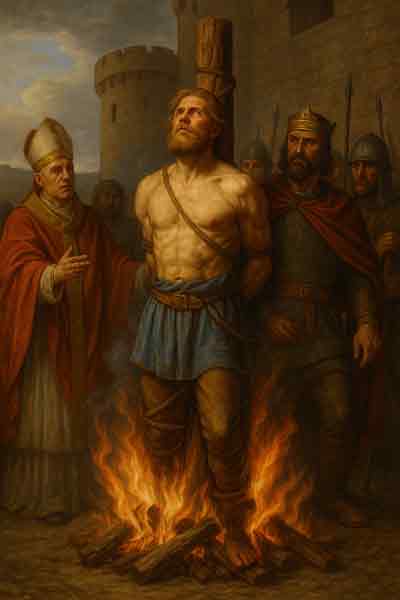
Some later traditions describe Hvitserk’s capture by enemies, possibly Christian rulers, who offered him a chance at conversion. In one version, Hvitserk embraces martyrdom, refusing to renounce his Norse beliefs and accepting death with defiance. These accounts blend historical speculation with spiritual symbolism, portraying Hvitserk as both warrior and victim—a man whose emotional turmoil brought him into contact with faith, mortality, and fate.
Other legends describe Hvitserk being executed by fire, a fate sometimes reserved for those who were feared or honored by their captors. In these tales, his death is not only physical but symbolic—a burning away of guilt, grief, and the legacy of violence he carried. Some sources suggest he suffered a mental or spiritual collapse before his execution, reinforcing the image of a man broken by the burden of his lineage and his deeds.
Whether viewed as a martyr, madman, or tragic hero, Hvitserk’s end underscores the emotional complexity that sets him apart from his brothers. His fate is a stark reminder that even in the age of Vikings—where glory was often written in blood—some stories were defined by their sorrow rather than triumph.
The Weight of Legend
Among the many sons of Ragnar Lothbrok, Hvitserk stands apart not for unmatched conquests or royal ambition, but for the emotional weight he carried through his life. His role in the Great Heathen Army and campaigns across England places him firmly in Viking history, yet it is his inner turmoil that gives his story depth. While his brothers are remembered for power and strategy, Hvitserk is remembered for loyalty, suffering, and the psychological scars of war and loss.
Hvitserk’s tale reveals the human cost of legendary greatness in many ways. His descent into grief and tragic end make him one of the most relatable figures in Norse tradition. His pain and passion mirror the darker truths behind the myth of the fearless Viking—a man shaped by battle but undone by its toll. Through Hvitserk, the sagas remind us that even legends can break.



